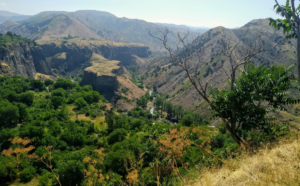Sevan National Park – Stunning Beauty in the Mountains

Sevan National Park
The landscape of Lake Sevan has been shaped by millions of years of volcanic eruptions. At some point, the steaming waters have cooled down and formed a lake of stunning beauty surrounded by snow-capped mountains. The coastline has woods, rocks, alpine meadows, pebble beaches and sea-buckthorn and pine trees. The territory around Lake Sevan belongs to the National Park, which is home for 267 bird species of which 39 species are included in the Red Book of Armenia. The park is one of the favorite places for birdwatching. Lake Sevan also has several sites of great historical relevance. One of them is Sevanavank monastery on the peninsula.
Location: Lake Sevan is in the Central Armenia, in Gegharqunik Province
Year of establishment: 1978
Fauna: famous Sevan trout, Armenian Gull, otter, brown bear, marten, forest cat
Nature

White Gull on “Gull Island”, Sevan
Sevan National Park incorporates a number of strict nature reserves. Norashen Reserve is one of them known as “Gull Island” and was established to protect a unique and well-known breeding ground of Armenian gulls.
Events
The annual harvest festival known as Vardavar is celebrated on a Sunday in July, usually 98 days after Easter. “Vardavar” derives from the Armenian word for rose and dates back to pagan times, when people offered roses to Astghik, the goddess of water, beauty, love, and fertility. Later it was integrated into the Christian baptism ceremony. This is the famous “bucket day” when all children and youngsters are allowed to pour a full bucket of water on anybody on this day. The region of Gegharqunik near Lake Sevan is particularly famous for its tradition of Vardavar celebrations, during which people throw water with roses on each other to cleanse their souls.
Did you know that the cemetery at Noratus village is home to the largest Armenian collection of “khatchkars”? You will find 900 cross-stones here varying in style and age. The prominent feature of many khatchkars, most of which date from 13th– 17th centuries, is a cross surmounting a solar disc. The rest of the stone is decorated with leaves, grapes, pomegranates or abstract patterns.
Tags: National Parks, State Reserves




